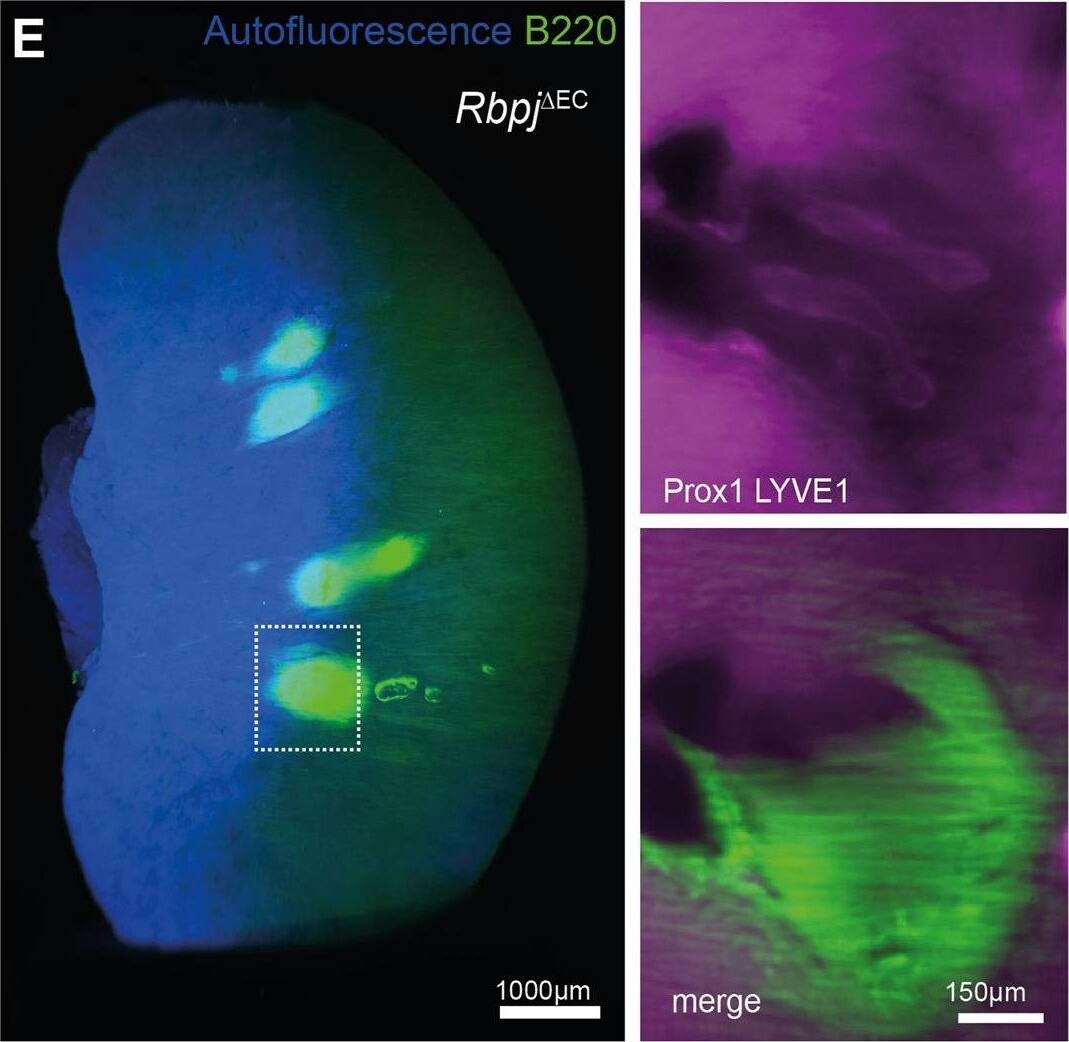LYVE-1 Products
Lymphatic Vessel Endothelial Hyaluronan (HA) Receptor-1 (LYVE-1) is a 60-kDa type I transmembrane glycoprotein that is a member of the Link Protein superfamily. HA is found in the extracellular matrix of most animal tissues and in body fluids. It modulates cell behavior and functions during tissue remodeling, development, homeostasis, and diseas...
188 results for "LYVE-1" in Products
188 results for "LYVE-1" in Products
LYVE-1 Products
Lymphatic Vessel Endothelial Hyaluronan (HA) Receptor-1 (LYVE-1) is a 60-kDa type I transmembrane glycoprotein that is a member of the Link Protein superfamily. HA is found in the extracellular matrix of most animal tissues and in body fluids. It modulates cell behavior and functions during tissue remodeling, development, homeostasis, and diseas...
| Reactivity: | Mouse |
| Details: | Goat IgG Polyclonal |
| Applications: | WB, IHC, Dual ISH-IHC |
| Reactivity: | Mouse |
| Details: | Rat IgG2a Monoclonal Clone #223322 |
| Applications: | WB, Flow, IHC, Block, CyTOF-ready, +1 More |
| Reactivity: | Human |
| Details: | Goat IgG Polyclonal |
| Applications: | WB, IHC, Block |
| Reactivity: | Human, Mouse, Rat |
| Details: | Rabbit IgG Polyclonal |
| Applications: | IHC, WB, Flow, CyTOF-ready |
| Reactivity: | Human, Mouse, Rat |
| Details: | Rabbit IgG Polyclonal |
| Applications: | IHC, WB, ICC/IF, Flow |
| Reactivity: | Mouse |
| Details: | Goat IgG Polyclonal |
| Applications: | WB, IHC |
| Reactivity: | Human |
| Details: | Mouse IgG2b Monoclonal Clone #264725 |
| Applications: | WB |
| Reactivity: | Human, Mouse |
| Details: | Rat IgG2 Monoclonal Clone #RM0033-4D17 |
| Applications: | IHC, WB |
| Reactivity: | Mouse |
| Details: | Rat IgG2a Monoclonal Clone #223322 |
| Applications: | Flow |
| Reactivity: | Mouse |
| Details: | Rat IgG2a Monoclonal Clone #223322 |
| Applications: | Flow |
| Assay Range: | 31.2 - 2,000 pg/mL |
| Applications: | ELISA |
| Reactivity: | Human |
| Details: | Goat IgG Polyclonal |
| Applications: | WB, IHC |
| Reactivity: | Human |
| Details: | Rabbit IgG Polyclonal |
| Applications: | IHC, WB, Flow, CyTOF-ready |
| Reactivity: | Rat |
| Details: | Sheep IgG Polyclonal |
| Applications: | WB, IHC |
| Reactivity: | Human |
| Details: | Mouse IgG2b Monoclonal Clone #1072614 |
| Applications: | Flow |
| Source: | NS0 |
| Accession #: | Q9Y5Y7 |
| Applications: | Bind |
| Reactivity: | Mouse |
| Details: | Rat IgG2a Monoclonal Clone #223322 |
| Applications: | Flow |
| Reactivity: | Human |
| Details: | Mouse IgG1 Monoclonal Clone #537022 |
| Applications: | Block |
| Reactivity: | Mouse |
| Details: | Rat IgG2a Monoclonal Clone #223322 |
| Applications: | Flow |
| Reactivity: | Human, Mouse |
| Details: | Rabbit IgG Polyclonal |
| Applications: | WB |
| Reactivity: | Mouse |
| Details: | Rat IgG2a Monoclonal Clone #223322 |
| Applications: | Flow |
| Reactivity: | Mouse |
| Details: | Rat IgG2a Monoclonal Clone #223322 |
| Applications: | Flow |
| Reactivity: | Human |
| Details: | Mouse IgG2b Monoclonal Clone #1072614 |
| Applications: | Flow |
| Applications: | AC |
| Applications: | AC |





![Immunohistochemistry-Paraffin: LYVE-1 Antibody [NB600-1008] Immunohistochemistry-Paraffin: LYVE-1 Antibody [NB600-1008]](https://resources.bio-techne.com/images/products/LYVE-1-Antibody-Immunohistochemistry-Paraffin-NB600-1008-img0050.jpg)
![Western Blot: LYVE-1 AntibodyBSA Free [NB100-725] Western Blot: LYVE-1 AntibodyBSA Free [NB100-725]](https://resources.bio-techne.com/images/products/LYVE-1-Antibody-Western-Blot-NB100-725-img0027.jpg)

![Immunohistochemistry: LYVE-1 Antibody (RM0033-4D17) - Azide and BSA Free [NB110-61026] Immunohistochemistry: LYVE-1 Antibody (RM0033-4D17) - Azide and BSA Free [NB110-61026]](https://resources.bio-techne.com/images/products/LYVE-1-Antibody-RM0033-4D17-Immunohistochemistry-NB110-61026-img0004.jpg)



![Immunohistochemistry: LYVE-1 Antibody [NB600-1005] Immunohistochemistry: LYVE-1 Antibody [NB600-1005]](https://resources.bio-techne.com/images/products/LYVE-1-Antibody-Immunohistochemistry-NB600-1005-img0011.jpg)



![Western Blot: LYVE-1 Antibody [NB100-726] Western Blot: LYVE-1 Antibody [NB100-726]](https://resources.bio-techne.com/images/products/LYVE-1-Antibody-Western-Blot-NB100-726-img0006.jpg)